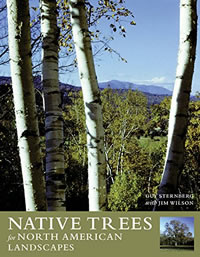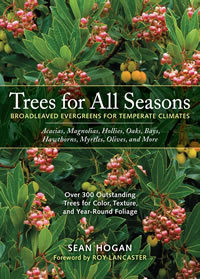Sponsored by the International Society of Arboriculture, this site offers factsheets on tree care and selection as well as a database for finding professional arborists anywhere in the world.
Keyword: Trees
Arbor Day Foundation
“Inspiring people to plant, nurture, and celebrate trees.”
Tree Physiology
Peer reviewed research; UW restricted.
Garden Tip #191
Silvics of North America Online by United States Department of Agriculture Forest Service, 1990.
Property owners with woodlots and tree lovers alike will find the Silvics of North America an informative and authoritative reference source on trees. Two hundred, mostly North American native trees are described including native habitat, associated trees and shrubs, propagation details, growth rate, and information on the major pests that may damage the tree. Many entries have information on the root development, which can be helpful in learning if a chosen tree will tolerate construction, or be appropriate for planting over water utilities.
Native Trees for North American Landscapes: From the Atlantic to the Rockies

In Native Trees for North American Landscapes: From the Atlantic to the Rockies , the sub-title is very important as trees native only west of the Rockies are excluded. But almost all trees that are included can be found in the Arboretum, and many are widely planted in our region and are available in nurseries.
As the title suggests, authors Guy Sternberg and Jim Wilson address their book to gardeners and landscape designers, but there is also much here to interest those who love trees for their place in the natural landscape and as interwoven with human history. The quality and diversity of the photography is impressive, and well linked with the engaging text.
Excerpted from the Summer 2012 Arboretum Bulletin.
Trees for All Seasons: Broadleaved Evergreens for Temperate Climates
 Portlander nurseryman Sean Hogan addresses a neglected part of the garden palette in “Trees for All Seasons: Broadleaved Evergreens for Temperate Climates”. And he does it with great enthusiasm; being quite candid that one of his goals is increased planting of these excellent but underused plants.
Portlander nurseryman Sean Hogan addresses a neglected part of the garden palette in “Trees for All Seasons: Broadleaved Evergreens for Temperate Climates”. And he does it with great enthusiasm; being quite candid that one of his goals is increased planting of these excellent but underused plants.
First, he defines his scope. Conifers, or monocots such as palms, are not included. He’s also strict about evergreen, subjects must “…keep their leaves year-round, or nearly so, but also remain attractive while doing so.” Icons with each entry give size and shape, and emphasize these are trees, not shrubs (he’s saving those for his next book).
The typical A-Z encyclopedia — with some bunching of closely related genera — is written for horticulturists (not botanists!) in temperate zones, and gives considerable gradation to the cold-hardiness and other exacting, cultural needs. For example, I learned that a favorite tree of mine from trips to the southwest, the Texas mountain laurel (Sophora secundiflora) would “…experience imperceptibly slow growth, or even lose ground…” in my Seattle garden without heroic efforts to match its preferred “swamp-cooler” climate.
Always the nurseryman, Hogan gives detailed notes about propagation and the habits of young nursery stock, always written in an easy to understand manner. Need to propagate your olive? Historically this was done by “chopping the heavily burled bases into pieces, pulling chunks out of the ground, then dragging them to the next area where, eventually, an olive tree would grow.” He goes on to say that with less effort similar results can be obtained from well-ripened cuttings with a high…ish level of hormone…along with a steep wound.”
This book will certainly enhance your appreciation of the Arboretum’s collection of broadleaved evergreens.
Excerpted from the Fall 2009 Arboretum Bulletin.